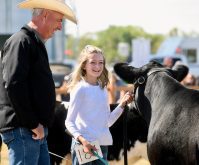Farm simulator games are popular but recently, young members of the Nomads 4-H Club near Kyle, Sask., had the opportunity to try a realistic cattle version when they joined a simulated feeder pilot project.
Buying and selling feeder calves on a large scale can be a challenge, with many factors affecting profit. To address the potential disconnect between 4-H members selling their steers for top dollar and real-world practicalities, Laura Culligan, a producer and 4-H parent, teamed up with Diane Van Essen of TEAM Auction Sales, to create a “sim-feeder” project for interested club members.
“It started out after our Achievement Day last year when we were brainstorming and thought about doing a simulated feeder competition that incorporated the realities of the industry and sourcing calves and backgrounding and selling them,” Culligan says.
Read Also

U.S beef industry faces demand risks and disease dangers
High beef prices and New World screwworm threaten beef demand and cattle health in the U.S.
Creating manageable steps
The project was developed to have three phases and each child found or was assigned a knowledgeable mentor they could consult at points throughout the competition.
Participating members first had to buy two hypothetical loads of calves at current prices. Next, they determined the costs and logistics of feeding them. Finally, participants had to decide on the best way to sell them in time for the yearling grasser market in the spring.
For each of the three stages, the kids participated in a workshop that outlined the main concepts and summarized cost considerations. Culligan drew on the expertise of Van Essen at stage one. “Diane is very knowledgeable on the technical aspects of marketing and sharing insight of different marketing platforms,” Culligan says.
“We toured a feedlot for stage two and spoke with people who were backgrounding a few different classes of cattle,” says Culligan. “Members learned about what makes up a ration and how you feed different types of cattle different rations to reach whatever your target weight is.”
Stage three involved marketing calves. Kids had to choose where and when they were selling, examine the costs of selling, and calculate profit or loss.
“They were really watching markets through these stages to see where the money is to be made,” Van Essen says.
Members were faced with making realistic decisions such as whether to implant heifers.
The entire project was competitive and the overall winner was based on profit per head at the end of the cycle. Participants were also evaluated along the way through a judging process that helped reward members who had a solid grasp of what they were doing, but perhaps didn’t hit the markets at the right time.
“We had a judge for each stage where the kids had to defend their production decisions,” Culligan says.
“For example, one member didn’t implant his heifers because he might sell them as replacements,” Van Essen says. It was valuable for the kids to get up and explain the rationale for their decision-making process, she adds.
Mentorship an important factor
Both women found that including mentors was a key element of the pilot project. Van Essen herself is currently in the Cattlemen’s Young Leaders program and is working with mentor Ryan Copithorne to build her skill set in marketing techniques and practices.
“The purebred guys do such an exceptional job of developing their youth in their industry but for the commercial sector, it can feel really out of touch to tap into this feeding industry and the people involved in it,” Culligan says. She found that this simulation helped break down those barriers and let young beef enthusiasts get a hands-on look at the feeding sector while simultaneously building communication skills. The members also built critical thinking skills and had to analyze their decisions in hindsight.
“Outside of workshops the kids worked with the mentors and bounced ideas off that person to help them think their way through the stages,” says Culligan.
“Ideally, kids found mentors that were actively feeding cattle and had a lot of skin in the game and were looking and watching all the way through,” Culligan adds. Some kids “purchased” similar loads of cattle in the fall but had very different outcomes by spring, and mentors played a big part in that, she notes.
“Something that was reiterated throughout the whole program was don’t be afraid to take a calculated risk,” Van Essen says.
She says the market can be fickle, but you need to ride it out over the long term. “I can’t reiterate enough that you can do everything right and still lose and do everything wrong and still win, but the guys that are the furthest ahead get back on the wagon.”
Levelling up skills
The objectives of this first year were to help members understand marketing platforms and forward contracting, learn costs and risks, and gain experience with proper terminology. It was also important to maintain member enthusiasm and keep it palatable for young kids.
“We decided to go with the backgrounding rather than finishing to keep it simpler for kids to get a grasp of the basic concept of purchasing calves in the fall and understanding different rations and how to go about marketing them,” Culligan says.
“What we’re heading into next will be a level two competition where kids are sourcing their own commodities and utilizing price insurance; tools that people are using and are very relevant,” Culligan says. As participants work their way through the process, they hope to get into the finishing stages at some point, she adds.
After the first year of the project, the leaders have looked at what worked and what could be improved, but are eager to expose the simulated feeder competition to a broader group of kids in the future. “We want to compile a list of possible mentors who want to take part,” says Culligan. “Find people who are willing to share and be connected.
“The goal at the end of the day is to get kids knowledgeable of different aspects of each stage.”
















